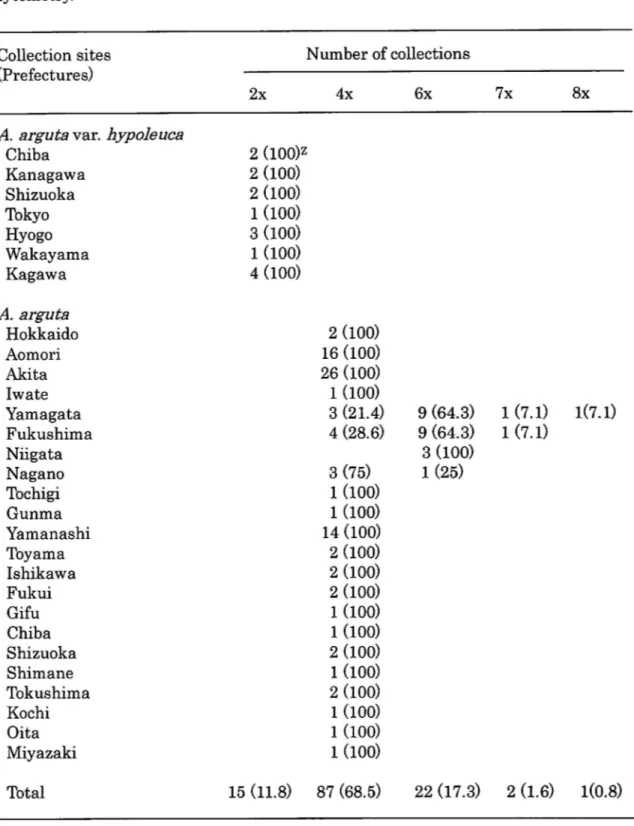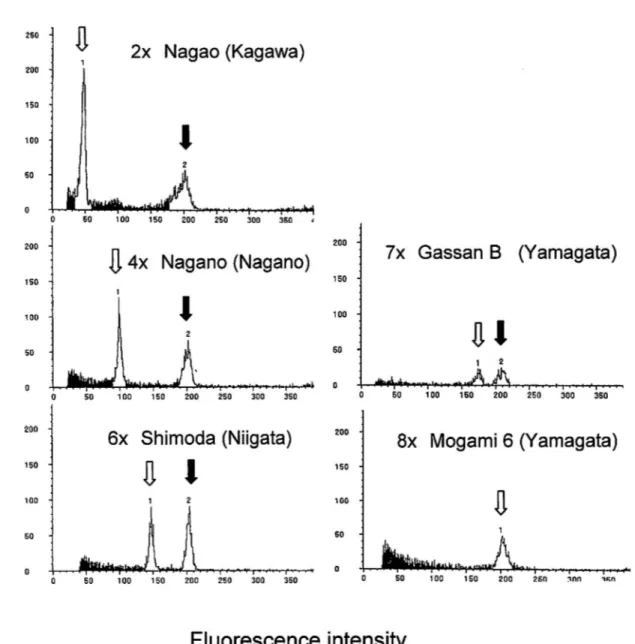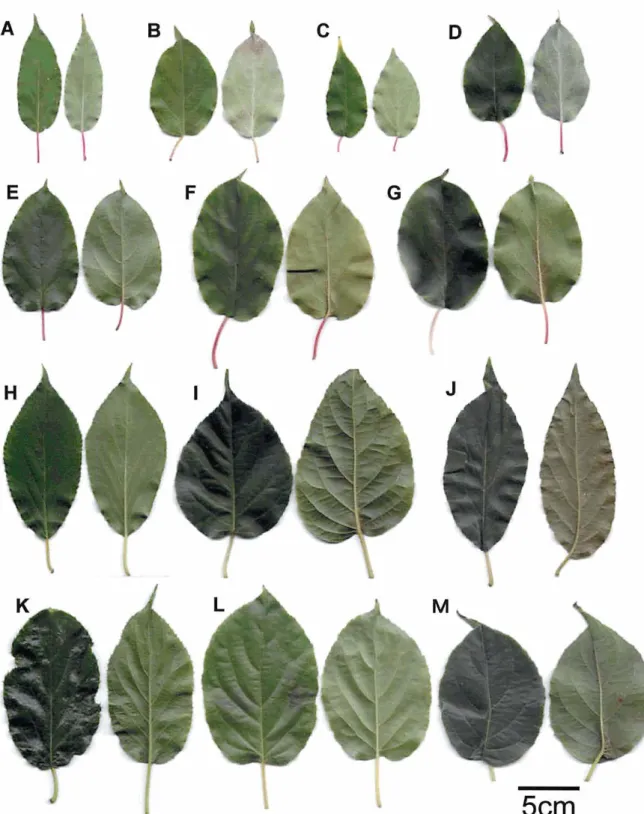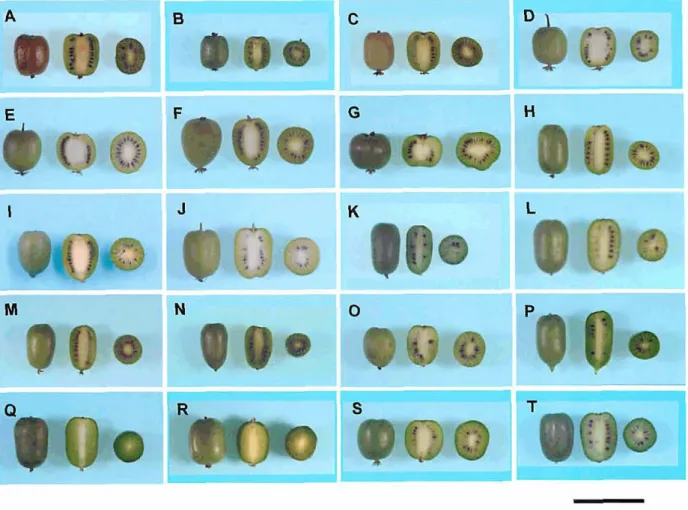Ploidy variation of hardy kiwifruit (Actinidia arguta) resources and geographic distribution in
Japan
Article type: Short Communication
Ikuo Kataokaa, Toru Mizugamia, Jin Gook Kima, Kenji Beppua, Tetsuo Fukudab, Shuji
Sugaharac, Koji ~ a n a k a ~ , Hirofumi Satohe, Kazuhiro ~ o z a w a ~
'~aculty of Agriculture, Kagawa University, Miki, Kagawa 76 1-0795, Japan
b ~ u c h u branch, Kagawa Agricultural Experiment Station, Sakaide 762-0024, Japan
'Yamagata Prefecture Murayama Regional Office, Shinj o, Yamagata 996-0052, Japan
d ~ o m o r i Prefectural Forestry Research Center, Hiranai, Aomori 039-3321, Japan
eAkita Prefecture Forest Technical Center, Kawabe, Akita 0 19-26 1 1 Japan
'yarnanashi Prefecture Forestry Research Institute, Masuho, Yamanashi 400-0502, Japan
*Corresponding author. Ikuo Kataoka, Tel.:+8 1 -(0)87-89 1-3066; fax: +8 1 -(0)87-891-3066.
E-mail address: kataoka@ag.kagawa-u.ac.jp
Abstract
Survey on the wild genetic resources of hardy kiwifruit (Actinidia arguta) in Japan was
conducted to determine the ploidy variation and its geographic distribution. Among the 127
wild plants collected from different geographic locations, 15 plants were diploid, 87 were
tetraploid, and 22 were hexaploid. Additionally, 2 plants were heptaploid and one plant was
hexaploid plants were geographically localized, in the warm Pacific hill areas of the south
western part and in the deep-snow region of the mid-northem part of Honshu, respectively.
The diploid plants could be clearly distinguished from other plants with ploidy variation by
the morphological characteristics of the leaf and fruit. Hexaploid plants showed a relatively
larger LID ratio of the leaf blade, a greenish petiole, and pubescence on the petiole and lower
leaf vein, whereas the tetraploid plants exhibited a reddish petiole and callose hairs on the
vein of the lower leaf surface. Fruit shape of the tetraploid plants varied largely, from round to
ellipsoidal, whereas that of the hexaploid plants was mostly ellipsoidal. These results indicate
that the hexaploid plants of A. arguta as well as the diploid and tetraploid ones, naturally grow
in a certain size of population in the restricted region of Japan.
Keywords: A. arguta; Hardy kiwifruit; Distribution; Flow cytometry; Morphology;
Polyploidy; Sarunashi
1. Introduction
Actinidia arguta known as hardy kiwi or bower vine is a cold-hardy species native to East-Asia (Ferguson and Huang; 2007). The fruit of A. arguta displays
a
hairless edible skinand a well-balanced sweet and sour taste with excellent flavor. It contains a larger amount of
vitamin C and polyphenols, and shows a high activity of a cysteine protease, actinidin
(Nishiyama and Oota, 2007; Kim et al. 2009), which promotes digestion and laxation in
commercially cultivated in Oregon in US, Chile and New Zealand, and small-scale production
for local consumption is conducted in many regions under a relatively cool climate (Kabaluk
et al., 1997; Ferguson and Huang, 2007). Due to the readiness in eating and the abundance of
the functional components for health, the market value of A. arguta fruit is increasing and
selection of superior cultivars is being attempted in several countries (Williams et al., 2003; Jo
et al. 2007; Latocha and Krupa, 2007; Stanicii and Zuccherelli, 2007).
In the taxon of A. arguta, it had been recognized that the ploidy varied largely, including
diploid, tetraploid, hexaploid, heptaploid and octaploid plants (Ferguson and Huang, 2007).
Tetraploid plants are most commonly distributed throughout East-Asia. A. arguta var.
hypoleuca found mainly in Japan was reported to be diploid (Watanabe et al., 1990), and A.
arguta var. purpurea growing in central China contains teteraploid and octaploid forms
(Ferguson and Huang, 2007). 'Issai' (Japanese name), which has been introduced to other
countries is estimated to be hexaploid (Watanabe et al., 1990; Yan et al., 1997, Kabaluk et al.,
1997). However, 'Issai' is not a true cultivar in Japan and its origin has not been determined
(Phivnil et al., 2005).
In Japan, A. arguta is called "Sarunashi". It occurs in mountainous areas all over the
country and the fruit has been locally utilized from old times. However, the evaluation of
these natural resources has not been systematically conducted. Watanabe et al. (1 990) counted
A. arguta, and of 'Issai' obtained from a commercial nursery, and determined that the ploidy
included diploid, tetraploid and hexaploid forms, respectively. This finding suggests the
existence of polyploidy in A. arguta resources in Japan. However, ploidy variation in the
population of wild plants has not been elucidated.
In a previous study, we determined the ploidy variation in the cultivar and local
collections of A. arguta in Japan and implied the existence of localized distribution of
hexaploid plants (Phivnil et al., 2005). Detailed information on the ploidy of natural resources
is essential to analyze their origin and dissemination, and is practically valuable for selecting
materials for breeding programs (Ferguson and Huang, 2007). In the present report the results
of field surveys on the ploidy variation and its geographic distribution in the wild resources of
A. argula in Japan are outlined.
2. Materials and Methods 2.1 Plant materials.
127 wild plants of A. arguta collected from the natural growing sites representing
different environmental areas in Japan, from north (Hokkaido, average yearly temperature;
8.0 "C) to south (Miyazaki in Kyushu, 16.9 "C). Local collections conserved at the regional
research stations were also used. Among them, 78 plants were propagated by cutting and
conserved in the research field of Kagawa University for morphological observation of leaves
2.2 Morphological observation
Five expanded leaves per plant were collected from the mid-position of the shoots and
the morphological characteristics were observed. Fully mature 10 fruit per plant were
harvested in mid-September, and the morphological characteristics of the fruit were observed,
After ripening of the fruit with ethylene treatment (Kim et al., 2009), total soluble solid
content (TSS) of the juice was measured using a hand refkactometer. Standard deviation was
calculated for each parameter in ploidy variance.
2.3 Flow cytometric analysis
Flow cytometric analysis was performed by the method described by Phivnil et al.
(2005). Expanding new leaves were collected from the shoot tips. A leaf segment 25 mm2 in
size without midribs was chopped with a razor blade in a plastic Petri dish with 0.5 ml of
ice-cooled nucleus buffer (solution A of high resolution DNA kit, Partech, Miinster, Germany)
and kept on ice for 5 min. After filtration through 20 pm nylon mesh, the samples were
treated with 2.5 ml of a staining solution containing 10 ml Tris, 50 mM sodium citrate, 2
m M
MgC12, 1% (w/v) PVP 30 (Wako Chemicals, Tokyo), 0.1 % (vlv) Triton X-100 and 2 mg-l" 4',
6-diamidino-2-phenylindole (DAPI), pH 7.5. After incubation of the mixture on ice for 30
sec., the fluorescence of the nuclei was measured using Ploidy Analyzer PA (Partech, Munster,
Germany) equipped with a mercury arc lamp. As an internal standard, Barley (Hordeurn
samples collected from each plant.
3. Results
3.1 Variation in ploidy and geographic distribution of the wild plants of A. arguta
The ploidy levels of A. arguta plants were clearly determined by flow cytometry (Fig. 1).
Among the 127 wild plants tested, 15 plants were diploid, 87 were tetraploid, and 22 were
hexaploid. Additionally, 2 plants were heptaploid and one plant was octaploid (Table 1). The
diploid plants were collected in the Pacific hill areas in the middle-part of Honshu and
southwards (Fig. 2). Tetraploid plants were found in 21 prefectures from Hokkaido in the
North and Kyushu in the South. In contrast, hexaploidy was observed only in the wild plants
collected in 4 prefectures in the mid-northern region of Honshu; Yamagata, Fukushima,
Niigata and Nagano (northern area). Additionally, two heptaploid and one octapoid plants
were identified in Yamagata and Fukushima prefecture.
3.2 Leaf and fruit characteristics of ploidy variants in the wild plants ofA. arguta
Leaf size was apparently smaller in the diploid plants than in the tetraploid and
hexaploid plants (Fig. 3, Table 2). The leaves of the diploid plants were also characterized by
the glaucousness of the lower surface. The shape of the leaves in the diploid, tetraploid and
hexaploid plants varied from ellipsoidal to ovate within the same ploidy. The LID ratio was
slightly larger in the diploid and hexaploid plants than in the tetraploid ones. Hexaploid plants
the petiole and lower leaf vein, whereas the tetraploid plants exhibited reddish petiole and
callose hairs on the vein of the lower leaf surface. Petiole was relatively longer in tetraploid
and hexaploid plants than diploid ones.
Fruit size in the diploid plants was relatively smaller than in the tetraploid and hexaploid
ones (Fig. 4, Table 3). Fruit shape varied largely from round to ovoid and ellipsoidal in the
tetraploid plants, whereas that of the hexaploid plants was mostly ellipsoidal. The fruit of the
two heptaploid plants were ellipsoidal and seedless. The fruit of the octaploid plant was ovoid.
TSS contents of the juice hardly differed among the ploidies.
4. Discussion
Through the survey on the wild plants collected in Japan, it was confirmed that A. arguta
displays a wide range of variation in ploidy namely diploidy, tetaraploidy, hexaploidy,
heptaploidy, and octaploidy. Except for the heptaploid and octaploid plants which might occur
incidentally, the diploid, tetraploid and hexaploid plants are likely to be naturally grown in a
certain size of population. Interestingly, the distribution of the diploid and hexaploid plants
was geographically localized.
Although, the systematics of A. arguta in Japan had been found to be complex
(Koizumi, 1940; Uehara, 1960; Kitamura and Murata, 1979), Ohba (2006) lately described
that A. arguta (Siebbold et Zucc. ) Planch. ex Miq. contained var. arguta and var. hypoleuca
hypoleuca by distinct morphological traits consisting of a whitish lower leaf surface and a
localized distribution in relatively warm Pacific regions. Additionally, Ohba (2006)
described that var. arguta contained a forma platyphylla (A. Gray)
H .
Ohba which ischaracterized by the callose hairs on the lower leaf surface, and put Japanese name:
KO-kuwa. However, the geographic distribution of the forma has not been distinguished
from the basic typical variety arguta.
In an empirical observation, Osawa (1993) identified a group of local collections grown
in the deep-snow region of Honshu that differed from the common type of A. arguta, and
designated it as "Dewa-no-Matatabi" following Nakai (1 9 13), meaning "native Actinidia
grown in Dewa, old name of northwestern mountainous area in Yamagata" in Japanese. He
noted that this group could be characterized by relatively larger fruit and leaves with greenish
petioles. The localization of the distribution of the hexaploid plants displaying similar
morphological characteristics to those described by Osawa (1993) strongly suggests that
populations with a higher ploidy are distributed in this area. The hexaploid 'Issai' (Fig. 3-M,
Fig. 4-T) might have been derived from this population.
The geographic segregation among the populations with different ploidy levels has been
reported in many plant species (Lewis, 1980). Generally, polyploids have been suggested to
be more adaptive to the new environment than the ancestral diploid. The geographic
adaptability to colder climate by reaching a higher ploidy level. Additionally, the hexaploid
plants may be evolved specifically in the deep-snow area of Japan Sea region.
The detailed mechanisms of occurrence of polyploidy and their phylogenetic evolution
in A. arguta in Japan should be investigated by cytogenetic and molecular analysis. Further
surveys on the ploidy variation of resources with superior horticultural traits and their
conservation are also important for breeding programs by intra- and interspecific
hybridization.
Acknowledgement
Part of this work was supported by Kagawa University Research Project (2004-2005) and
JSPS KAKENHI (20580031). We greatly thank Mr. N. Nakajima, Dr. K. Watanabe, Mr. I.
Satoh, Ms. A. Saga, Mr. A. Ohsawa, Mr. R. Tukida, Ms. N. Matsumoto, Mr. 0. Todo for their
assistance in the collections of plant materials.
References
Ferguson, R., Huang, H., 2007. Genetic resources of kiwifruit: domestication and breeding.
Horticultural Reviews, ed. Janick, J., 33 : 1
-
12 1.Jo, Y.S., Ma, K.C., Cho, H.S., Park, J.O., Kim, S.C., Kim, W. S., 2007. 'Chiak' a new
selection of Actinidia arguta. Acta Hort. 753,259-262.
Kabaluk, J.T., Kempler, C., Toivonen, P.M.A. 1997. Actinidia arguta - characteristics relevant
Kim, J.G., Beppu, K., Kataoka, I., 2009. Varietal differences in phenolic content and
astringency in skin and flesh of hardy kiwifruit resources in Japan. Sci. Hort. 120, 55 1-554.
Kitamura, S., Murata, G, 1979. Actinidiaceae. In Colored Illustration of Woody Plants of
Japan. vol. 2. Hoikusha Publishing Co., LTD. Osaka. pp. 162- 168. (in Japanese)
Koizumi, G. 1940. Actinidia in Japan. Acta Phytotaxonomica et Geobotanica. 9, 97-99 (in
Japanese).
Latocha, P., Krupa, T., 2007. Morphological, chemical and sensory analysis of promising
genotypes of hardy kiwifruit obtained in the breeding programme at WILS. Annals of Warsaw
University of Life Sciences. 28, 1 1 1
-
1 19.Lewis, W. H. 1980. Polyploidy in species populations. In W. H. Lewis (ed.) Polyploidy:
biological relevance, Plenum Press, New York, USA. pp. 103- 144.
Nakai, T., 191 3 . Acrinidia in Japan. Bot. Mag. 27: 163-1 64. (in Japanese)
Nishiyarna, I., Oota,
T.,
2007. Fruits of the Actinidia genus. Adv. Food Nutr. Res. 52,293-324.Ohba, H., 2006. Actinidiaceae, In (ed.) Iwatsuki, K., Boufford, D.E., Ohba, H.) Flora of Japan.
vol. 1Ia. Kodansha Ltd., Tokyo. pp. 391 -393.
Osawa, A., 1993. Efficacy of Wild Plants for Health - Culture and Utilization. Japan
Horticulture Association. Tokyo, pp. 1 97-203. (in Japanese)
Phivnil, K., Beppu, K., Takamura, T., Fukuda, T., Kataoka, I., 2005. Flow cytometric
Rush, E.C., Patel, M., Plank, L.D., Ferguson, L.R., 2002. Kiwifruit promotes laxation in the
elderly. Asia Pac.J. Clin. Nutri. 1 1, 164- 168.
Stanica, F., Zuccherelli, G., 2007. New selections of Actinidia arguta forrn the Romanian
breeding program. Acta Hort. 753,263-267.
Uehara, K., 1960. Actinidiaceae. In Encyclopedia of Tree with Illustration. vol. 2, Akebono
Shobo. Tokyo. pp. 1 194- 1202. (in Japanese)
Watanabe, K., Takahashi, B., Shirato, K., 1 990. Chromosome numbers in kiwifruit (Actinidia
deliciosa) and related species. J. Japan. Soc. Hort. Sci. 58, 835-840.
Williams, M.H., Boyd, L.M., McNeilage, M.A. MacRae, E.A. Ferguson, R.A., Martin, P.J.,
2003. Development and commercialization of 'Baby Kiwi' (Actinidia arguta Planch). Acta
Hort. 610,81-86.
Yan, G., Yao, J., Seal, A.G., Murray, B.G., 1997. New reports of chromosome numbers in
Table 1. Estimation of ploidy level of local collections of A.arguta i n J a p a n b y flow cytometry.
Collection sites (Prefectures)
Number of collections
A. arguta var. hypoleuca Chiba Kanagawa Shizuoka Tokyo Hyogo Wakayama Kagawa A. arguta Hokkaido Aomori Akita Iwate Yamagata Fukushima Niiga t a Nagano Tochigi Gunma Yamanashi Toyama Ishikawa Fukui Gifu Chiba Shizuoka imane Sh' Tokushima Kochi Oita Miy azaki Total
Table 2. Leaf characteristics of ploidy variants in A. arguta native to Japan. Ploidy level Leaf Petiole Length (cm) Width Length LID ratio (cm) (cm) Diploid plants 6.9
*
3.0 4.1*
2.4 1 . 7 k 0.5 2 . 4 k 1.3 Tetraploid plants 11.5 k 2.4 7.5 k 1.9 1.5 0.2 4.0 k 1.5 Hexaploid plants 11.4*
2.4 6.4 k 1.5 1.8 k 0.2 3.4 k 1.4 Means*
SD, n= 15(diploid), n=87(tetraploid), n=22(hexaploid)Table 3. Fruit characteristics of ploidy variants in A. arguta native to Japan Ploidy level Weight
(8) Length (cm) Width (cm) L/D ratio TSS (%) Diploid plants 4.8 =tT 1.0 2.3 f 0.2 1.8 f 0.1 1.2 =fi 0.2 1 1 . 1 f 0.4 Tetraploidplants 8.1 k 3.0 2.7 f 0.3 2.4 =tT 0.3 1.3 0.2 12.8 f 1.2 Hexaploid plants 8.9
*
2.9 2.9 f 0.5 2.1 i 0.3 1.4 f 0.1 12.2 f 2.3 Means+
SD, n=3 (diploid), n=8 (tetraploid), n= ll(hexap1oid)260
/
(1
Z x Nagao (Kagawa) 200 Io 60 loo 150 zoo 250 300 3sn i
0
4x Nagano (Nagano) 7x Gassan B (Yamagata)1 50 2 0 0 / I 150
Fluorescence intensity
4 200 - 150 - 100-
60 - 0Fig. 1. Histograms of frequency distribution of fluorescence intensity obtained from DAPI-stained nuclei i n A. arguta collections. White and black arrows denote fluorescence intensity of sample and Barley (Nordeum vulgarel, respectively.
0 50 100 150 200 250 300 350 0 50 100 150 200 26n ~ n n ? ~ n 6x Shimoda (Niigata)
a
1
150 - 100 - 60 - 8x Mogami 6 (Yamagata)a
1 I . . ' - 0$
Pacific ocean
Fig. 3. Leaf morphology of ploidy variants in A.arguta in Japan
Diploid plants; A: Zushi (Kanagawa), B: Myojogatake (Kanagawa), C: Oishi (Wakayama)
D: Nagao (Kagawa)
Tetraploid plants; E: Misaka (Yamanashi), F: Nagano (Nagano), G: Hirano (Fukushima) Hexaploid plants; H: Gassan A (Yamagata), I: Shimoda (Niigata), J:Otari (Nagano) Heptaploid plants; K: Gassan B (Yamagata) Octaploid plants; L: Mogami 6 (Yamagata)
Fig. 4. Fruit of ploidy variants in A. arguta in Japan
Diploid plants; A: Myojogatake (Kanagawa), B: Miki (Kagawa), C: Izu (Shizuoka),
Tetraploid p1ants;D: Hirano (Fukushima),
E:
Nagano (Nagano), F: Otoyo (Kochi),G: Mogami 1 (Yamagata), H: Mogami 2 (Yamagata), I; Sanbe (Shimane)Hexaploid plants; J: GassanA (Yamagata), K: Otari (Nagano), K: Shimoda (Niigata), L: M:Hinoemata (Fukushima), N: Tadami (Fukushima), 0: Gassan04A (Yamagata), P: Mogami 4 (Yamagata),
Heptaploid plants; Q: GassanB (Yamagata), R: Aim (Fukushima),
Octaploid plants; S: Mogami 6 (Yamagata)





